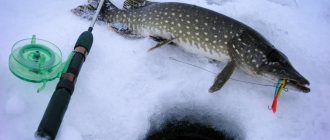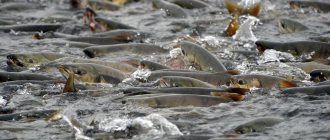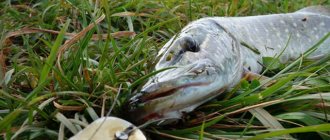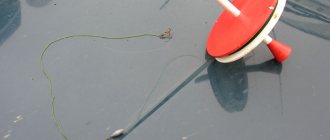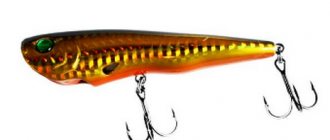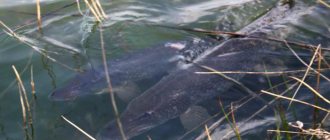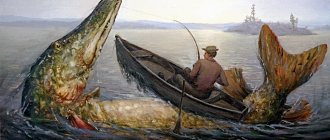Pike spawning may be an unproductive period of the year for an angler when selectively hunting for this fish, common in our country, but it can still be considered a fundamental moment in the life of a predator that produces offspring, and, consequently, the possibility of successful fishing in future periods. It is important for the fisherman to follow the rules of fishing during the breeding of fish, excluding not only the extraction of trophies, but also observing the principles of careful treatment of their spawning grounds.
For a conscientious fishing enthusiast, noticed attempts by careless fishermen to illegally catch a predator should be strictly suppressed both by their own forces and by the forces of nature conservation, which controls the sphere of recreational fishing. Only such approaches will make it possible to preserve and increase the population and number of pike, which will delight the fisherman with bites and hunting results.
The article presented below will be about the peculiarities of the behavior of the toothy predator not only during its mating season, but also in the time periods preceding this action and unfolding after the completion of spawning. The fisherman will learn about the places in which the predator sets up spawning grounds, when it does this and at what age it becomes sexually mature and ready for reproduction, and we will devote a separate chapter to the prohibitions being established by law during the period of pike spawning.
Features of spawning
Mature pike is a predatory fish that leads a solitary lifestyle. An adult individual inhabits a certain territory of the reservoir, which it adheres to throughout its life, patrolling and staying briefly at promising hunting sites to catch suitable prey. The usual behavior of a predator is to ambush behind natural or artificial cover and wait for a fish or other small animal of suitable size to swallow. The parking lots alternate with short transitions from one promising ambush point to another. And so on throughout the year, with the exception of a couple of weeks of mating games.
When the time of pike spawning approaches, it brings together individuals of equal size and mass into small groups of seven or ten, forcing them to migrate to the shallows in search of spawning sites, where they stay for a couple of weeks, completely immersing themselves in the breeding process. During spawning time, the predator finally switches off from the mode of hunting and searching for food, stopping any feeding activity. Pike noticeably lose their aggressiveness and, to a certain extent, vigilance, behaving recklessly in shallow waters, where they can often become easy prey for a poacher equipped with a spear, pike or hook.
In addition, due to the violent behavior of the breeding predator, spawning grounds can be easily detected by the frequent splashes and turning of the spotted sides to the surface of the water by massive fish. Having spawned, the fish immediately moves to deeper places in the reservoirs, never again being interested in the fate of the offspring that begin to hatch from the eggs.
At what age does pike spawn?
Of course, spawning is the fate of fully formed, mature and healthy fish. Pike is not classified as a slow-growing fish species, but at the same time it is not a record holder for weight gain or precocity. Depending on the type of reservoir, its size and oxygen regime, as well as the saturation of the food supply, the rate of fish maturation varies significantly in terms of time. In large bodies of water with excess oxygen throughout the year and the presence of a large population of carp fish species, pike grows quite quickly, reaching maturity among females by three years, and males a year later.
Important! The size and dimensions of an adult pike ready for spawning will be at least 30 cm in length and weigh half a kilogram.
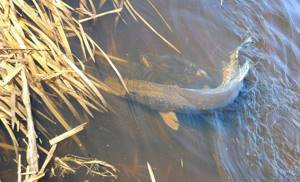
In small ponds with a small influx of water and a poor food supply, female pikes become sexually mature at four years, and males will only be able to participate in producing offspring in the fifth or even sixth year of their life. Comparing the presented time frames, we can note a rather long time course for the development of fish into a sexually mature individual capable of reproduction. So, in reservoirs with strong fishing pressure, without anglers using the catch-and-release principle, the pike population can be quickly destroyed within two or three years, without giving it a chance not only to recover, but even to replace the fish that are being taken.
Pike spawning video
You can see how pike behave during spawning and what happens in this video.
Pike is a popular trophy among anglers. But it is better to postpone its capture until after spawning. And if you suddenly find fry in a drying puddle, then try to move them to the nearest body of water, because only a small part of them will survive until the end of the first year.
Views: 1,774
Similar articles:
- Where to look for pike? Searching for fish on lakes and rivers depending on the conditions of the reservoir and the time of year When catching pike with a spinning rod using artificial bait, the rule applies: “Do not...
- Pike fishing in March: where to look and what to catch March fishing, depending on the vagaries of nature, may fall on…
- What is the best time to catch pike In the general chorus of opinions about what time to fish...
- Fishing for pike on small rivers with a spinning rod It’s no secret that the number one trophy for a spinning angler is pike….
How many times a year does pike spawn?
Pike spawning occurs only once during the calendar year. Of course, from year to year the time period for the beginning and end of reproduction may shift slightly, which is expressed only in a week-long delay or an earlier start of the process.
Important! Shifts in spawning periods directly depend on weather conditions associated with warming up water and melting ice.
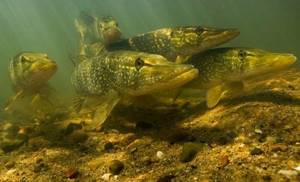
The annual life cycle of a predator can be divided into three distinct phases, the largest of which will be preparation for spawning, which the fish begins to do from mid-summer until spring, gradually storing calories and increasing its appetite to ensure the maturation of milk and eggs. A short, couple of week phase of the spawning itself and a two-month rest phase of the predator after reproduction.
When does pike go to spawn?
Pike spawning begins at the end of winter and directly in the spring itself, which depends on the type of reservoir and weather conditions favorable for spawning. Regarding the structure of reservoirs, it is worth noting that first of all, the predator begins its mating games in the upper reaches of small rivers, which are cleared of ice cover earlier, and therefore the water in them warms up faster, reaching a temperature of 4–8 degrees, which stimulates fish to spawn. Closed, stagnant ponds with relatively shallow depths are the last to be cleared of ice, already in stable above-zero weather. Thus, even in reservoirs located within the same region at short distances from each other, pike begins to spawn with a possible time interval of one and a half months.
On rivers, pike can spawn at the end of February, and on a pond shaded by trees even at the beginning of April. In addition to the structure of the reservoir, weather conditions also affect the spawn. The strong thaws of the early spring, rapidly opening up the reservoirs, stimulate the predator to start spawning early. A long winter can delay the spawning season for a considerable time. Based on the conditions presented above for the start of pike spawning, we can safely conclude that the probability of spawning of the predator is within the limits of the end of February and until the first ten days of April.
When does spawning and feeding of pike begin in spring?
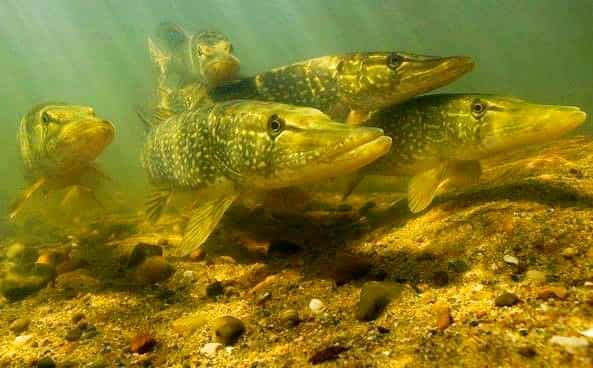
In the spring in February-March, pike go to spawn like crazy (the water temperature becomes 3-7 degrees). In advance, a few days before spring spawning, the toothy predator begins to eat.
After exhaustion, the thin and exhausted pike goes to the mouth of the flowing rivers and to the edges. Here she devours everything and everyone in her path.
Pike never spawn in the beds of large rivers; they go to spawn in small rivers and streams. You can often see three or four pike ridges sticking out among the grass in shallow water.
This is a female playing with males.
https://youtu.be/BpglWcQ4_nk
Pike spawn at three to four years of age. Such young pike are called “blue feather”, as their fins are very bright at this age.
After these three to four year olds, older pike go to spawn. The spawning period of pike can last about a month.
You can go fishing for pike at any time of the year. A poor catch can only be observed during spawning. I mean sports excitement, and even at this time the pike is busy with mating games - it has no time for gluttony. But this period passes quite quickly.
At the beginning of spring, the predator also reacts well to bait. But before you go fishing for pike, you need to first learn more about its habitats and the fishing method.
Where does it spawn?
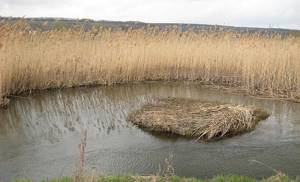
As we already know, the harbinger of pike spawning in the spring is considered to be the melting of ice and the subsequent natural slight warming of the water. With the emergence of these situations, the so-called pike run begins, when sexually mature individuals begin to unite in small schools, where there are two or three males for one female. The predator leaves its usual and habitual habitats and begins to move towards shallow waters and spills, in which the first aquatic vegetation begins to awaken and grow.
The fish goes to the upper reaches of large rivers, entering small river channels and backwaters, where deep water levels do not exceed one meter. On stagnant lakes and ponds, the predator lives in shallow waters where the bottom is covered with aquatic vegetation, snags and driftwood. When setting up spawning grounds, the fish avoids noisy places, the background of which is created by active human activity. The spawning ground itself, during the active phase of spawning, is a seething cauldron of fish rubbing against each other, sometimes jumping out of the water and often showing their backs with straightened bright fins on the surface of the reservoir.
In the excitement of mating, a pike can even jump onto the shore, subsequently actively wriggling and moving its body until it slides into the water. Spawning on floods is fraught with the death of fish offspring, which can occur as a result of a rapid drainage of water and, as a result, drying out of the delayed game. In the best case of spawning, the eggs stick to plants or snags, after a week they turn into pike larvae, and after another month, small pike are already capable of attacking fish mallow.
How does pike behave before spawning?
With the appearance of thawed patches on the rivers and the disappearance of ice, fish tired from wintering begin their movement to spawning grounds. During its migration, even when it has already gathered in flocks, the predator does not stop actively feeding. But small fish become food items, which applies even to large-sized pike. This is due to the fact that the belly of the predator is densely filled with caviar and milt, leaving no room in the stomach for large prey. In addition, the long and relatively insatiable winter season does not leave much energy for the extraction of large and fast food items.
Fishermen have noticed that the start of the predator’s move is accompanied by its increased activity. The so-called spring pre-spawning glutton for pike is especially noticeable on large rivers with a good oxygen regime in the water, which increases the activity of the fish. In ponds and lakes suffering from a lack of oxygen, pike may not show any feeding activity at all before spawning, saving the rest of their energy for spawning itself. Fishing during this period is not prohibited and fish can be caught quite successfully using a spinning rod, loading small-sized and aggressive baits with bright colors.
Features of pike fishing in autumn
When the first cold snap occurs, this is the beginning of September, the pike, brought to the point of exhaustion by the summer heat, begins to come to its senses and emerge from its half-asleep state. At this time, she simply amazes with her gluttony. The time has come for fishermen to catch pike. An unbridled appetite turns her into a reckless, unguarded fish that is easily hooked.
Autumn is characterized by the pre-winter feast of pike; this is a golden time for spinning anglers.
In addition, unlike in spring, there are no prohibitions on autumn fishing, which means you can fish for your own pleasure and still get a decent catch. Related article: 10 tips on how to make your zig rig more effective
How does pike behave after spawning?
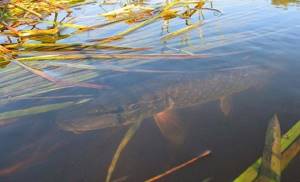
After the pike's spawning is over, the female will go to rest and within five to seven days will come to her senses without showing any feeding activity. The males will remain in shallow water, waiting for the next batch of pikes to approach the spawning ground, with the males from which the old-timers of the spawning ground often engage in fights that are serious in intensity. Subsequently, all the fish weakened by spawning will remain standing at the bottom at the boundaries with shallow waters, saturating the gills with oxygen.
Often smaller young males become victims of large females, who begin to actively feed after settling. The post-spawning period is the most difficult time for a predator, since the fish that overwintered and gave birth to offspring has completely depleted its energy reserves and requires a serious replenishment of vital resources. Stationary fish in parking areas are exposed to danger from poachers, who calmly collect tired fish with nets and grabs in places where they are densely concentrated.
When does pike start biting after spawning?
You can expect the toothfish to start biting only on the 15th–20th day after the start of spawning. Thus, the spawning itself will take about 10–12 days, and the rest of the fish will take about a week. By tracking these time intervals, the angler can safely go hunting, if this is not prohibited by calendar dates, using live bait or artificial bait as bait. Live bait is considered a more promising bait than imitators, which the fish preferred during the pre-spawning period. Having rested and gathered strength, the spawned pike begins to feed greedily, devouring any prey. The post-spawning feast begins, which will last with varying degrees of intensity until the end of May. Compared to the zhor in the fall, the post-spawning zhor is considered to be more productive in terms of fishing results, but shorter in time.
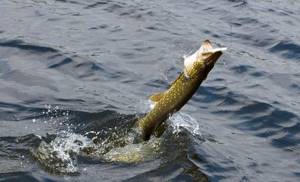
Important! The peak of the bite occurs during the flowering of bird cherry and the blossoming of oak leaves.
Floods cause inconvenience for fishing on rivers, complicating approaches to promising places for feeding fish. It is easier to fish on ponds in spring due to more convenient approaches and the relatively small size of the reservoir. With saturation, by the end of May, the predator goes to calm waters in bays and backwaters on rivers and backwaters on lakes and reservoirs, where it settles into so-called summer apartments, setting up ambushes in water thickets, becoming picky and capricious in choosing a victim suitable for attack.
What baits are best for pike in early spring?
If you plan to catch pike in March using a spinning rod, silicone baits with lightweight jig heads are considered the best. They weigh from 5 to 15 g.
Since the predator is quite hungry in March, inedible vibrotails or twisters will be quite acceptable for it. Perhaps see how the pike reacts to the oscillating spoon.
All these recommendations will help the angler get a good catch in early spring. And don’t forget that after the spring spawning, the pike begins to eat again, which I mentioned above - after the May holidays, when the dandelion blooms.
Prohibitions during spawning
The fisherman should be reminded that when pike spawn, there are a number of categorical prohibitions on catching the predator. In addition to the direct ban on catching toothfish, the use of any swimming equipment is limited or completely prohibited. In addition, throughout the entire spring season, in many reservoirs fishing is allowed using only one tackle and one hook, single double or triple, regardless of the type of bait, with casting only from the shore and without entering the water.
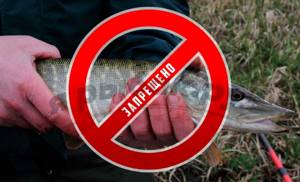
From region to region of the country, the terms of the bans are shifted according to calendar time, the value of which is introduced by the authorities regulating and protecting natural resources based on the actual conditions on water bodies. Before planning a pike fishing session, it is worth familiarizing yourself with the fishing rules in the place where you are fishing, so as not to subject yourself to huge fines, and not to limit the fish’s ability to reproduce and replenish their population.
A five or seven year old female pike is capable of laying up to several hundred thousand eggs, which can significantly increase the number of predators, therefore, when catching a brood fish, the fisherman must remember to preserve and increase natural resources, which in the future will please not only him, but also many others of the same kind. like-minded people passionate about pike fishing.
Subtleties of pike fishing in October. And why doesn’t the pike bite in the autumn zhor.
Greetings to all subscribers and guests of this fishing channel.
And I would like to immediately thank you for reading the articles, because any author cannot live without readers. Otherwise he will have no reason to write!
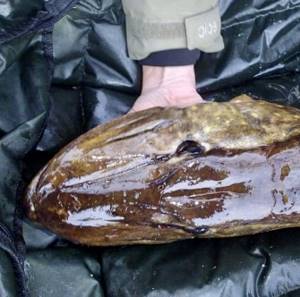
Today I will tell you why everyone catches pike in the fall. But you don't!
And also, I’ll tell you a little secret (maybe it’s not a secret for some). And I’ll tell you what to do if the pike doesn’t bite.
I think that everyone has had the experience that you come to work, and a colleague tells you how he caught pike on almost every cast over the weekend. And you, like a normal fisherman, have a burning desire to go fishing this coming weekend.
And now the weekend has arrived.
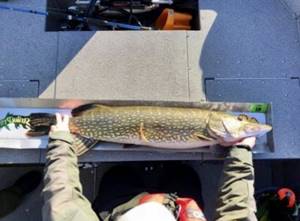
You, having collected your entire arsenal of gear, from the very early morning go to this “miracle” river or any other body of water where your work colleague caught a mountain of these “toothy monsters”. And you have a “bummer” while fishing. Instead of a bunch of trophy pike, at best you only manage to catch a few “pencils”.
It's a shame, isn't it?
Just understand, although it is generally accepted that pike are hungry in the fall, this does not mean that you will 100% catch huge pikes. And even more so if you only fish on weekends!
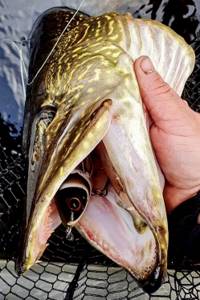
Absolutely any angler can be left without a catch in the fall. Let him at least have “super-pupper” professional gear. This is far from an indicator!
There are many reasons for the lack of bites, but I’ll still tell you a few secrets.
For example, you may have chosen the wrong size and color of the bait.
Accordingly, it is worth changing the bait periodically while fishing and trying other wobblers, silicone, and spinners. Well, or what are you fishing for there?
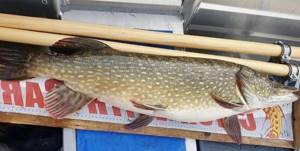
And also, the lack of bite may be due to the fact that you are fishing from the shore. Where there is little depth. But now it’s autumn, the water has cooled, and the pike stays closer to the holes and pools. And there are two options: either you study the reservoir and select a place, or a boat can help you.
Also, perhaps you are fishing at the wrong time of day for pike.
You may have the wrong wiring for your bait.
And in windy weather you need to fish from the leeward side.
If you fish with wobblers, then try them with others, with greater or less depth. After all, pike is not a predictable fish. She can take bait like two. Same with the surface of the water.
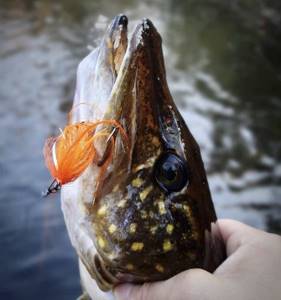
In short, fishing experiments are our everything!
And yes, I know that for experienced fishermen these are not secrets at all, but you don’t have to compare everyone to yourself! I know a lot of people who really benefit from these articles.
Well, if you don’t agree with something. You are welcome to leave a comment and there we can discuss this.
I wish all subscribers and readers NHNC!
Source
